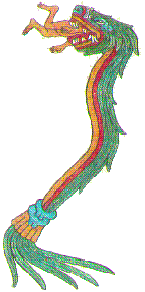Content created: 2001-01-06
File last modified:
Brief Notes on Classical Nahuatl

- Material on This Page
- What's Nahuatl?
- Nahuatl Pronunciation
- Material on Other Pages of This Site
- Inadequate On-Line Lessons in Classical Nahuatl (A quick introduction with very easy interactive exercises.)
- Inadequate Reference Grammar of Classical Nahuatl
- The Aztecs: A Tributary Empire (A short history of the Aztecs)
- An Aztec Folio (Short readings on Aztec life and thought, mostly bilingual.)
- Selected Bibliography of Useful Books
- Day of the Dead in San Andrés Mixquic (An ethnographic account of this festival as practiced in a Nahuatl-speaking community.)
- Selected On-line Nahuatl Resources on Other Web Sites
- Dictionnaire de la Langue Nahuatl Classique, easily the best on-line collection of Classical Nahuatl resources, including an easily consulted Nahuatl-French Dictionary, grammar, lists of proper names, maps, etc. (In French with some Spanish translations.)
- Nahuatl (Aztec) Language (jumpsite)
What is Nahuatl?
Nahuatl is a language spoken in south-central Mexico. It was the administrative language of the Aztec empire, and accordingly was of great interest to the Spanish immigrants who later inherited the administration of Mexico. The kind of Nahuatl respresented in early Colonial texts is referred to as "Classical," in contrast to Nahuatl as it has been spoken in more recent times.
Because a knowledge of Nahuatl was so important to the early Spanish, it was an object of scholarly concern already by the mid-XVIth century. Accordingly we have a long record of it, and in some ways this makes it one of the most interesting of the indigenous American languages to study. Indeed Nahuatl can become a consuming passion.
Although there are still speakers of Nahuatl, it is probably safe to say that all but the most elderly among them are bilingual in Spanish; and in general, later Nahuatl shows influence of Spanish as well as a continuing evolution of trends that were already going on in early Nahuatl. (Click here for historian John Schmal's informative page about continuities in the use of Nahuatl in Mexico.)
Return to top of page.
Spelling & Pronunciation of Classical Nahuatl Words
Because the spelling of Nahuatl was originally based on spelling conventions in XVIth-century Spanish, Nahuatl texts are generally "pronounced like Spanish," with the following exceptions and points to note:
- Words are stressed on the second-to-the-last vowel (excluding U) regardless of final consonants.
- X is pronounced like English SH.
- LL is pronounced like a long L (not as in Spanish).
- TL counts as a single consonant, never as a full syllable.
- U does not occur as an independent vowel. The only Nahuatl vowels are A, E, I, and O, although each of them can be long or short. (A long O tends to sound like a U.)
- CU and UC are both pronounced KW. (UC is sometimes spelled CUH.)
- HU and UH are both pronounced W.
- H without an adjacent U represents a "silent" glottal stop (as in go_over); in modern Nahuatl it sometimes has a sound similar to an English H and may have had that value in some dialects of Classical Nahuatl as well. (For an English speaker, pronouncing the H like an English H is not really wrong and has the advantage that it helps one remember that it is there.)
- C before E or I is pronounced like English S. (The letter S is not used in Classical Nahuatl.)
- Z is pronounced like English S. (The letter S is not used in Classical Nahuatl.)
However over the centuries there has been considerable instability in the spelling of Nahuatl. Some common variations:
- The letters U and O may be used interchangeably to represent the sound of O.
- The letter U alone may be used instead of UH or HU to represent the sound of W.
(At the time of the Conquest, the written letters V and U were usually reversed in Spanish from their modern values, so U indeed had the value of a modern English W.)
- The letter H representing the glottal stop may or may not be written. (The Spanish tended not to hear it, so it was often omitted.)
- Vowel length may or may not be marked. Usually not.
- The consonant Y may be written with the letter I.
- The vowel I may be written with the letter Y.
- The letter Ç (C with a cedilla under it) may be used in place of Z to represent the sound of S.
Beginning in the XXth century American linguists working with modern Nahuatl have sometimes preferred spellings that look less Spanish (and "coincidentally" more English). Thus:
- W may be used in place of HU or UH for the sound of W.
- K may be used in place of QU/C for the sound of K.
- S may be used in place of Z/C for the sound of S.
In some cases other letters, available on no keyboard and included in very few type fonts, are used for TL, CH, CU/UC, and TZ to stress that these are single consonants, not compounds.*
*-Weird letters are an occupational hazard of being a linguist. Ordinary mortals find them hard to understand and harder yet to type.
Return to top.
Unsolicited translations of this page are available as follows. Note that because they seem to have been produced as translation exercises for English classes, the translated pages are not normally updated.
- French by David Wardell
- docs.google.com/document/d/1QZ0JsWrDZJ3DsdM_XOynuEeZxd9c8o-03zAi_KLbPs4/preview
(Linked 2019-03-26)
- Uzbek by Fodor
- flyclipart.com/uz-nahuatl
(Linked 2019-03-07)
The background design is patterned on the famous "Coyolxauhqui Stone," a magnificent bas-relief found at the foot of Huitzilopochtli's pyramid at the Templo Mayor in Mexico city. It represents the dismembered goddess, hacked to bits by her brother.
